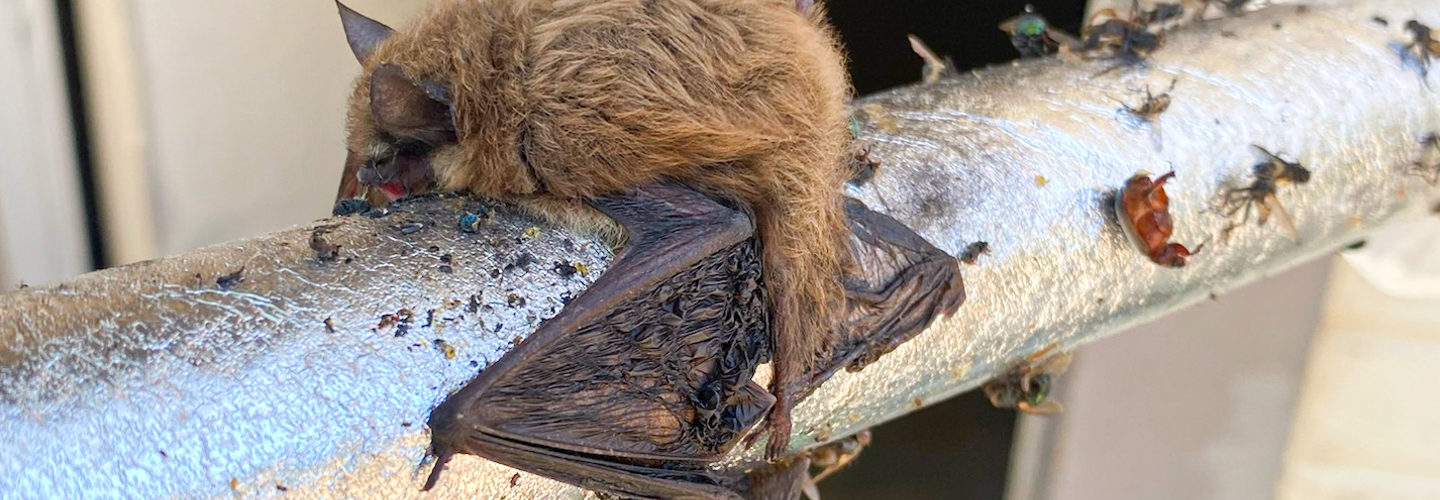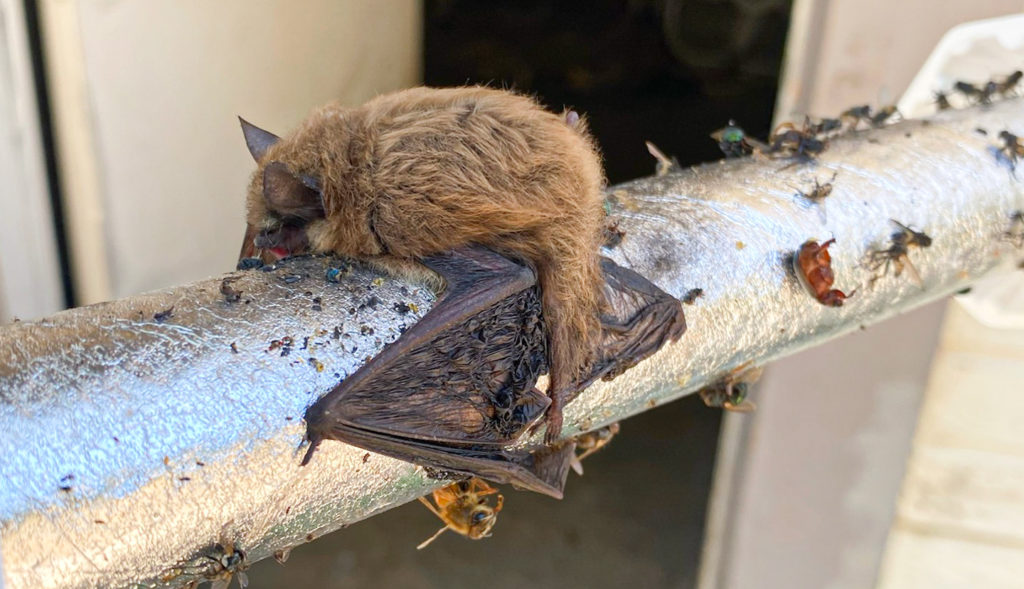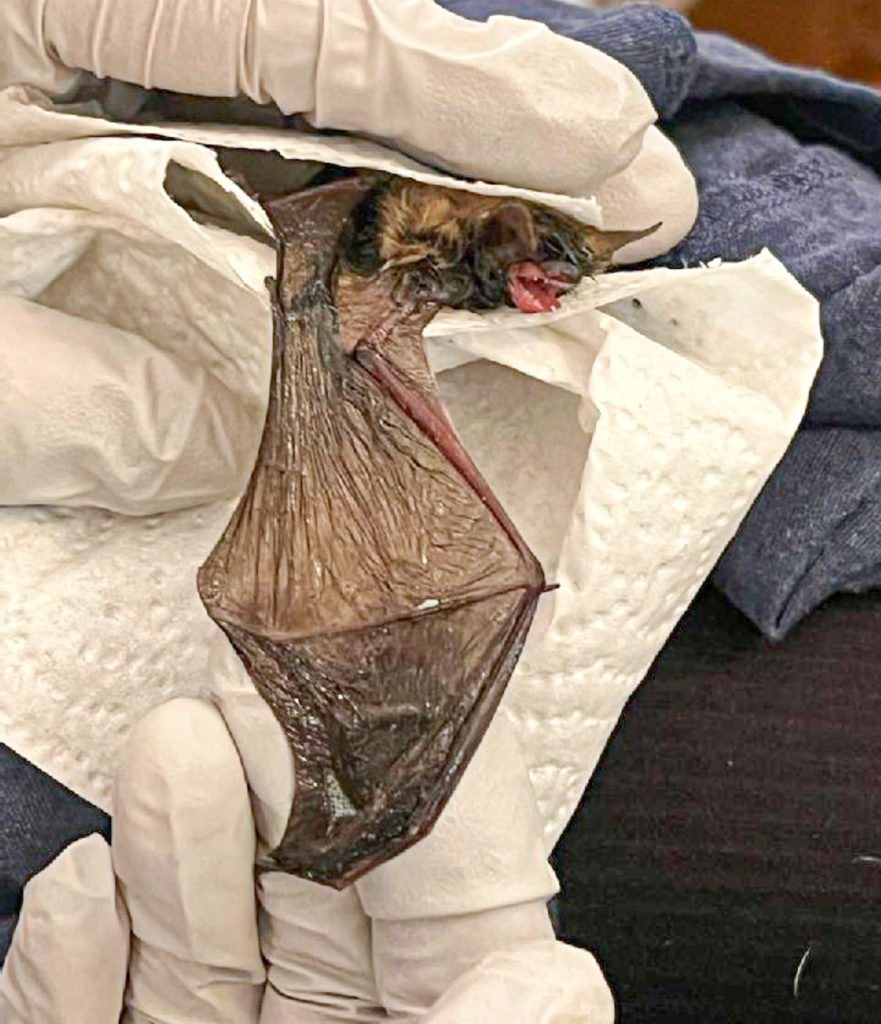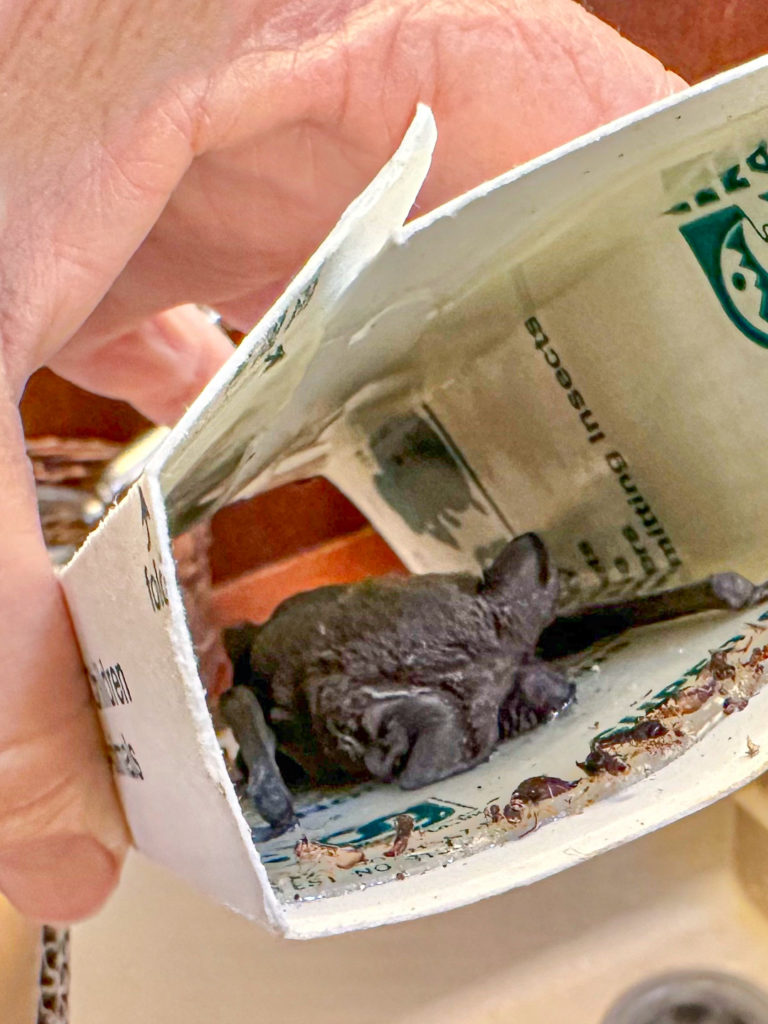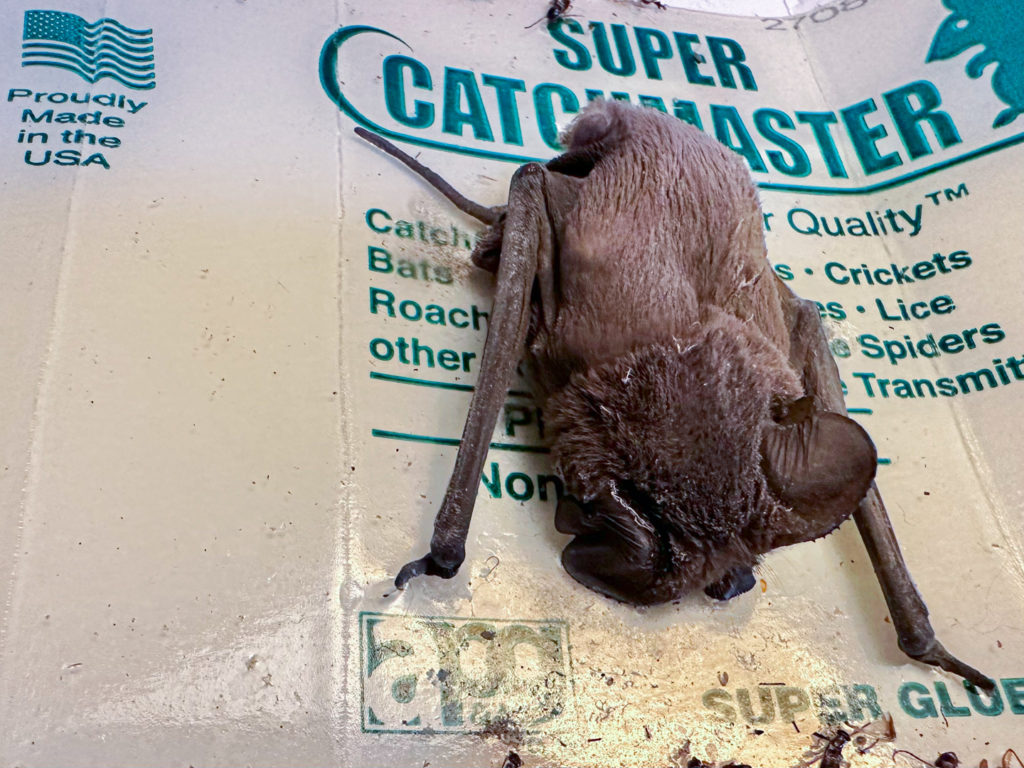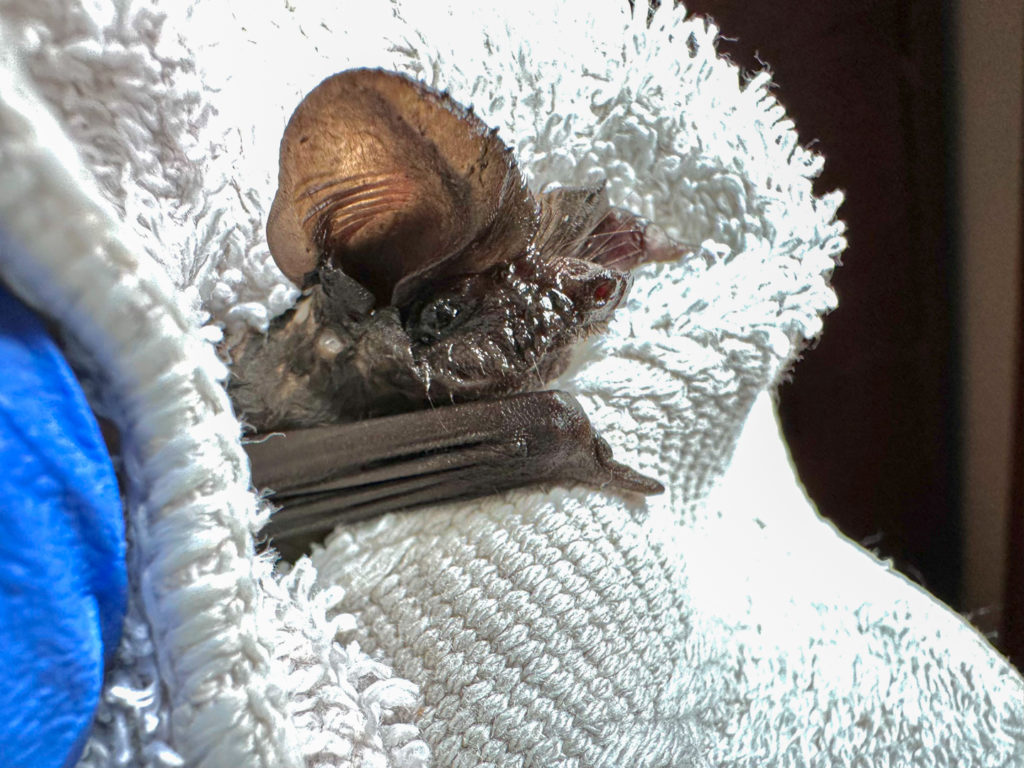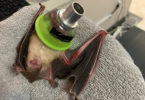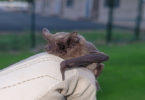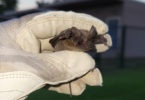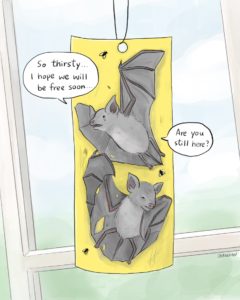 Sticky traps are a commonly used pest control device. Do you have a flying insect problem? Sticky traps are simple to use and very cheap. Just hang one up and insects stick to them. Crawling insects? There are sticky traps built for pests on the ground. However, did you know that both of these kinds of traps can be a major hazard for bats and many other animals? Think about it – you have a lot of flying insects around, insect-eating bats are drawn in to catch them, and if the bat comes into contact with the trap, WHAM, they are stuck. Sticky traps endanger bats! In fact, they are cruel and endanger ALL kinds of wildlife!
Sticky traps are a commonly used pest control device. Do you have a flying insect problem? Sticky traps are simple to use and very cheap. Just hang one up and insects stick to them. Crawling insects? There are sticky traps built for pests on the ground. However, did you know that both of these kinds of traps can be a major hazard for bats and many other animals? Think about it – you have a lot of flying insects around, insect-eating bats are drawn in to catch them, and if the bat comes into contact with the trap, WHAM, they are stuck. Sticky traps endanger bats! In fact, they are cruel and endanger ALL kinds of wildlife!
Let’s take a look at some examples of what a sticky trap can do to a bat, based on our experience at NorCal Bats, how we work to save them. This often is a sad, hard story.
Sticky Trap Bat Rescue
In June 2022 a male long-eared Myotis bat was brought in to NorCal Bats, firmly entangled with a type of sticky trap used to catch flying insects. It became entangled during the night, and most likely had been struggling for hours before it was found. The more it struggled, the more it was stuck! If it hadn’t been found and brought into bat rescue, it would have slowly died from dehydration and stress.
As it struggled to free itself, the bat’s tail membrane had separated from the tail, and it tore several small holes in one wing.
The process of trying to save a bat from a sticky trap can take many days. The first step is to try to remove the bat from the glue-coated trap. This is done with forceps and scissors, very carefully removing the sticky material from the trap base. This doesn’t remove all of the trap material, but it makes it easier to do the next step.
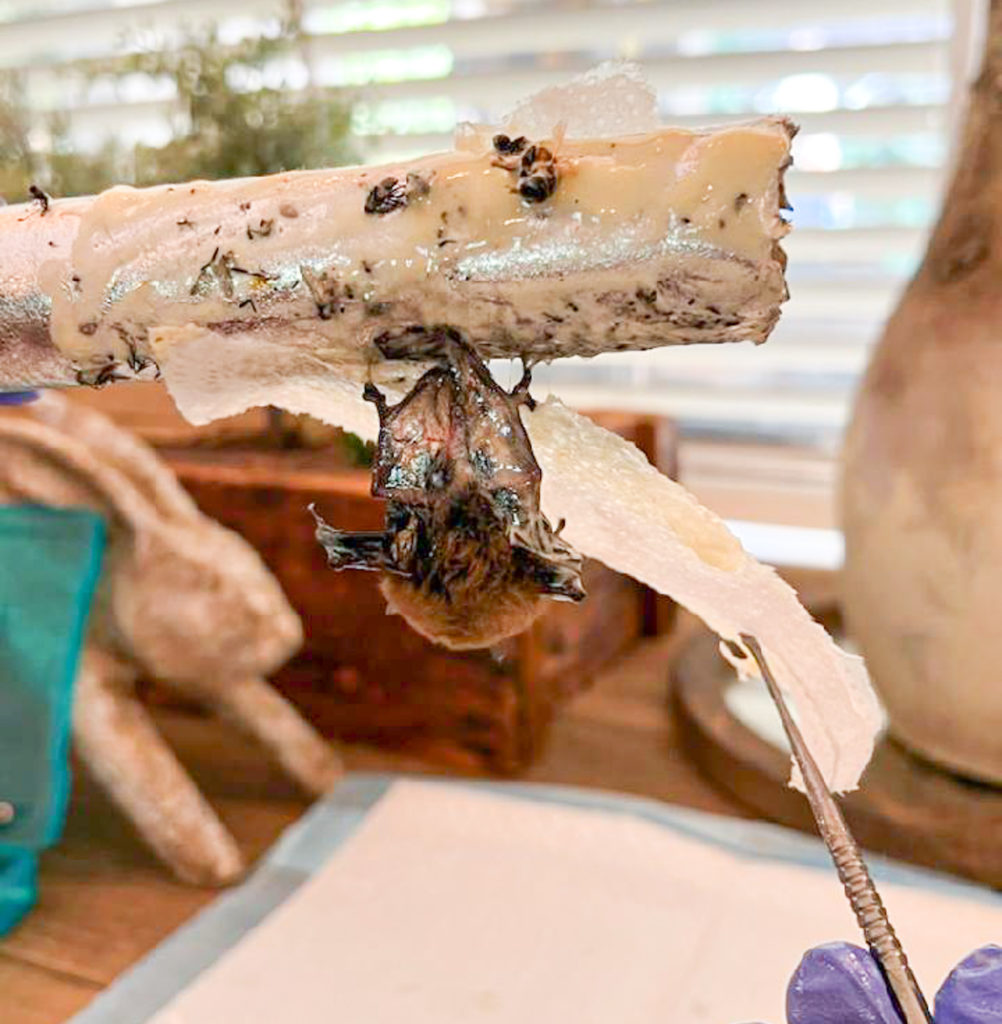
Removing the sticky material
Once the majority of the trap material has been separated from the base, the bat needs to be removed from the remaining trap substrate. This substrate is still coated with the very sticky glue, which also covers large areas of the bat. Not only does the bat need to be removed from the remaining trap material, the glue must be removed quickly before the bat tries to clean itself. The glue can be toxic to the bat if ingested. Separating the bat from the glue and substrate was done, in this case, with coconut oil applied with a cotton swab.
The next step is to carefully wash the bat with a non-toxic detergent. This was done 3 times in the first day. In addition, the bat received subcutaneous fluids (twice on the first day), along with a non-steroidal anti-inflammatory for pain.
On the second day it was washed again and given additional subcutaneous fluids. By this point the bat was eating again, fairly well.
Unfortunately, the stress was too much for this bat, and it died on day 4.
Another Bat Rescue, Better Results
In January 2023 a Mexican free-tailed bat flew into a commercial building, where it headed to a corner and hid out of sight. An employee of the business saw the bat fly in, and she went looking for it to see if she could help it find it’s way outside. Crawling around in the corner, looking amongst the potted plants and furniture, the rescuer discovered the bat stuck fast in a glue trap that had been set of the floor, most likely to catch mice or insects.
The poor bat was stuck by his feet, tail, wings, an ear, and right cheek.
The rescuer brought the bat to NorCal Bats, and our team went to work. Fortunately, the bat had been discovered right after it was entangled with the trap, so it was in good health (not dehydrated) and not as firmly stuck as it could have been.
To start, the box shaped trap was cut open with scissors. The bat was tightly stuck by its right cheek and ear, with the nostrils just barely above the glue.
Next, olive oil was gently applied, and along with some careful pulling the bat was freed from the trap.
The bat was given a bath with Dawn liquid dish soap, a gentle detergent to remove the olive oil and any attached glue. This was done quickly to keep the bat from ingesting any of the glue, which can be harmful to the bat.
In the next photo, the bat is still wet from his bath. Mexican free-tailed bats have huge ears. He is facing to the right and we are looking at his right wing and thumb in front of his face. He’s in a washcloth.
At the time this article was written (early March), the bat is in good health and has learned to eat mealworms on its own out of a dish. When the weather warms up enough this bat will be released. Success!
Sticky Traps are Cruel
Sticky traps (also called glue traps, fly strips, glue boards) trap anything that comes into contact with them. They are indiscriminate killers, trapping insects, bats, birds, reptiles, rodents, and even pets!
They don’t usually contain pesticides. The trapped animal dies from dehydration, starvation, and exhaustion. That is a cruel way to die. To be honest, they don’t really solve your pest problem. If one pest is killed this way, it just makes room for another to move in. If you want to remove pest animals from your home, it is better to try to close off the openings where they are gaining entry, and remove food or garbage items that may be attracting them.
These kinds of traps are banned in several places in the world, such as Victoria BC, Australia, and New Zealand. However, many countries, including the United States, have no regulations on these products. There also is very little consumer education about the effect of these products.
Please note: Never try to remove the animal from the trap yourself. Contact a wildlife rescue organization or wildlife rehabilitator for assistance.
My thanks to Joan Chan, Happy Valley Bats, and Batworld, for permission to post this graphic.
Here are a few additional links:
- Help stop the use of glue traps
- Glue traps are heinously cruel. Retailers should be banned from selling them
- The Humane Society of the United States
- The Dangers of Glue Traps
- The Perils of Glue Traps
- Fly trap catches, terrorizes and injures several small bats

